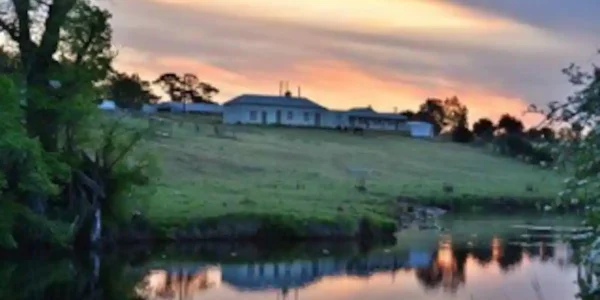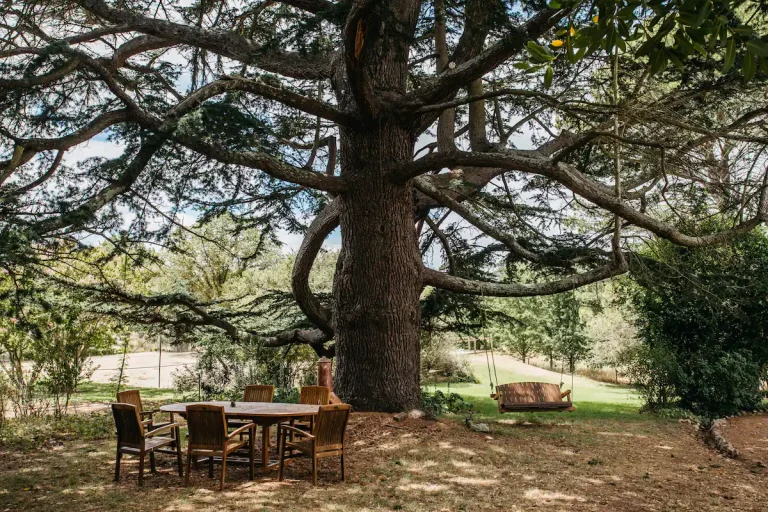About
Kippilaw Homestead is a historic Georgian-style property located in the Goulburn district of New South Wales. Its rich history dates back to the 1830’s. Today, over its 400 acres straddling the Wollondilly River, Kippilaw stands angus cattle,a miniature donkey stud, extensive grounds and gardens and some of the most historic buildings in NSW.
Kippilaw Homestead
The Chisholms were a prominent pioneering family in Australia, arriving from Scotland in the early 19th century. In the 1830s, James Chisholm and his wife, Elizabeth, were granted 1,280 acres of land in the Goulburn region. They named their property Kippilaw, a combination of the Pictish word “kippi” (meaning “little”) and the Saxon word “law” (meaning “hill”). Kippilaw became the Chisholm family’s rural headquarters, serving as a center for their extensive agricultural operations. The homestead also played a significant role in the local community, hosting social events, parties, and gatherings.
The Homestead's grounds and animals
The Chisholms’ generosity and hospitality at Kippilaw were celebrated by Australian author Mary Durack in her 1959 seminal work “Kings in Grass Castles.”. In more recent years, Kippilaw has been carefully preserved and restored, maintaining its historic character. Kippilaw Homestead now stands as a testament to the history of early colonial Australia. Its significance lies not only in its architectural beauty but also in its role as a social and cultural hub during a formative period in the nation’s development. Today, apart from its historic and beautiful buildings and grounds, including a hectare of rose gardens, a productive orchard, and a boulevard of century old English Oak trees, Kippilaw also hosts a herd of circa 100 Angus breeders, and a miniature donkey stud, with a jack and 12 jennies.

Across the Wollondilly River and adjoining Kippilaw is St James’ church. This church is maintained by the Clan Chisholm, the descendants of the Chisholm family. The Clan Chisholm recounted the following historical account of Kippilaw;
In the early days of the colony of New South Wales, travel on the few roads out of the first major settlement, Sydney, was hazardous. Not only were the roads rough and unmade and subject to the weather at the time, the responsible citizen was a prime target of the bushrangers, who preyed on travellers. They would hide in the bush, in a conveniently dense forest area and pounce on a lonely conveyance making its way to the next staging post–usually a remote inn. “Stand and deliver” was the cry as the bushranger, sometimes with accomplices, would bail up the coach, brandishing his firearm.
One of the frequent travellers on the roads of early New South Wales was Mr. James Chisholm, son of the early settler, also James, who had come to the colony from Mid Calder outside Edinburgh, as a member of the New South Wales Corps, to keep the peace, in 1790. James, the elder, elected to remain in the colony after the expiry of the period of service of his regiment in 1810, having acquired property and a family. He had married Mary Brown in 1806, and they had one son, James. Mary died in 1817, and James later remarried, producing a large family before his death in 1837.
From his early days in the colony, James the elder began to acquire land, often paying in goods. His grandson, also James, described payment for one transaction in his book “Speeches and Reminiscences” as “4 gross port wine, 6 gallon hollands, 2 pieces broadcloth, 5lbs American tobacco, 1 chest tea, 2 bags sugar, 1 set harness for a gig, 1 saddle, 1 bridle, 1 single barrelled fowling piece, 2 canisters powder, 4 bags of shot”. This sort of transaction was quite common at that time as the colony was very isolated and very dependent on infrequent supply ships.
In addition, James was one of the lucky settlers to be granted a “Rum Licence”. These licences were granted by the governor to a small number of free gentlemen. As rum was the only liquor in the colony it became a more important currency than money. At his property in what is now central Sydney, James set up an inn, the Thistle Inn, one of the earliest and better known establishments. As a result, he prospered exceedingly and was able to buy and receive grants of land in the expanding colony. As James, his son, grew and received his education, he went on to learn about stocks and property and gradually joined his father in running the farms. Between them, the two James Chisholms acquired much property over the years and by the 1830s held vast sheep country in the Goulburn district–some 195 kms south from Sydney. In addition to this, James senior had bought a property in the Narellan district, then on the outskirts of the colony, which he called Gledswood, and it was here that young James took over the management and running of the farm, extending the original house and building a substantial colonial home.
When James, the younger married in 1829, he therefore had control of the Gledswood property, where he took his new bride, and the administration of the property in Goulburn. This involved many staff members on the land–from overseers to convict labourers. In those days the farming community was allowed convict labour to run the farms and also took in free settlers who came to the colony to make a new life. James, in his dealings with these farm workers gained the reputation of a kind and fair employer, which was often an exception to the rule, as some landholders were very harsh masters.

By the end of the 1830s, James, the son, had moved his family to live on the Goulburn property, called ‘Kippilaw’, after a property in the Melrose area of Scotland where James’ wife Elizabeth (nee Kinghorne) had lived. When they married in 1829, Elizabeth, in line with the practice at the time for free settlers, received a grant of land from the then governor of the colony, Lachlan Macquarie. This was an acreage in the Goulburn district, adjacent to her father’s holding and formed the ‘home acreage’ of the Kippilaw property, with additions from the Chisholms. With the Gledswood property near Sydney and the Goulburn holding the family was often on the road for some days with their family that eventually numbered nine sons, travelling by horse and buggy, or by the Cobb and Co. stagecoach, which became a by-word in the transport of goods and people in the colony.
One day, on the Liverpool Road, which in those days was well and truly in the country but is now well within the Sydney metropolitan area, James and his wife were travelling by coach only to be held up by a notorious bushranger, by the name of Jack Donahoo. In the usual way, Donahoo demanded and seized all valuables from the occupants of the coach. However, on learning that one of the occupants was Mr. James Chisholm, he returned their valuables saying:
“I have always heard that Mr. Chisholm was a good master to his men and if I had known you were on the road you should never have been molested.”
So much for the good reputation of one of the early pioneers of the colony of New South Wales, James Chisholm became a Member of the Legislative Assembly and an active promoter of agriculture in the Goulburn area, as well as a trustee of the new Anglican Cathedral to be built in Goulburn. As already mentioned, he was well known as a kind employer to both his convict laborers and free settlers whom he employed on his lands. A story is told that he once gave his gloves to a convict at the Kippilaw property to protect his hands on a very cold day.
Kippilaw’s sunken garden also has historic origins. This garden was built by staff under the supervision of Sir Harry Ralph Seymour Chisholm, who developed this garden as a tribute to his late wife, Lady Editha Chisholm. Sir Harry was born in 1888, and was an Australian soldier who served as an officer (Lieutenant Colonel) with distinction in the First World War, at Gallipoli and on the Western Front. Sir Harry passed in 1961, after serving several terms as Goulburn mayor and President of the RSSILA (now RSL).